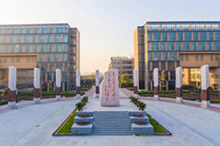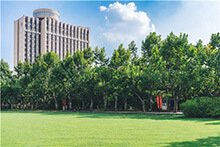2015上外翻译硕士真题
为你全程答疑
送翻硕资源、报录数据等
时间:12.27下午2:00~5:00
一、Filling following blanks with a word.
Nicholas Kristof is a New York Times columnist.
©2014/the new york times
American Dream is Leaving America
The best escalator to opportunity in the US is education. But a new study underscores that the escalator is broken.
We expect each generation to do better, but, currently, more young American men have less education (29%) than their parents than have more education (20%).
Among young Americans whose parents didn’t graduate from high school, only 5% make it through college themselves. In other rich countries, the figure is 23%.
The US is devoting billions of dollars to compete with Russia militarily, but maybe we should try to compete educationally. Russia now has the largest percentage of adults with a university education of any industrialized country—a position once held by the US, although we’re plunging in that roster.
These figures come from the annual survey of education from the Organization for Economic Cooperation and Development, or OECD, and it should be a shock to Americans. A basic element of the American dream is equal access to education as the lubricant of social and economic mobility. But the American dream seems to have emigrated because many countries do better than the US in educational mobility, according to the OECD study.
As recently as 2000, the US still ranked second in the share of the population with a college degree. Now we have dropped to fifth. Among 25-to-34-year-olds—a glimpse of how we will rank in the future—we rank 12th, while once-impoverished South Korea tops the list.
A new Pew survey finds that Americans consider the greatest threat to our country to be the growing gap between the rich and poor. Yet we have constructed an education system, dependent on local property taxes, that provides great schools for the rich kids in the suburbs who need the least help, and broken, dangerous schools for inner-city children who desperately need a helping hand.
Too often, the US’s education system amplifies not opportunity but inequality. My dad was a World War II refugee who fled Ukraine and Romania and eventually made his way to France. He spoke perfect French, and Paris would have been a natural place to settle. But he felt that France was stratified and would offer little opportunity to a penniless Eastern European refugee, or even to his children a generation later, so he set out for the US. He didn’t speak English, but, on arrival in 1951, he bought a copy of the Sunday edition of The New York Times and began to teach himself—and then he worked his way through Reed College and the University of Chicago, earning a PhD and becoming a university professor.
He rode the American dream to success; so did his only child. But while he was right in 1951 to bet on opportunity in the US rather than Europe, these days he would perhaps be wrong. Researchers find economic and educational mobility are now greater in Europe than in the US.
That’s particularly sad because, as my Times colleague Eduardo Porter noted last month, egalitarian education used to be the US’s strong suit. European countries excelled at first-rate education for the elites, but the US led the way in mass education.By the mid-1800s, most American states provided a free elementary education to the great majority of white children. In contrast, as late as 1870, only 2% of British 14-year-olds were in school.
Then the US was the first major country, in the 1930s, in which a majority of children attended high school. By contrast, as late as 1957, only 9% of 17-year-olds in Britain were in school.
Until the 1970s, we were pre-eminent in mass education, and Claudia Goldin and Lawrence Katz of Harvard University argue powerfully that this was the secret to the US’s economic rise. Then we blew it, and the latest OECD report underscores how the rest of the world is eclipsing us.
In effect, the US has become 19th-century Britain: We provide superb education for elites, but we falter at mass education.
In particular, we fail at early education. Across the OECD, an average of 70% of 3-year-olds are enrolled in education programmes. In the US, it’s 38%.
In some quarters, there’s a perception that American teachers are lazy. But the OECD report indicates that American teachers work far longer hours than their counterparts abroad. Yet American teachers earn 68% as much as the average American college-educated worker, while the OECD average is 88%.
Fixing the education system is the civil rights challenge of our era. A starting point is to embrace an ethos that was born in the US but is now an expatriate: that we owe all children a fair start in life in the form of access to an education escalator.
Let’s fix the escalator.
二、Answer following questions大概,有出入)
1、Why did the author’s father leave for America?
2、What is educational mobility like in Europe?
3、According to Claudia Goldin, what is the secret to the US’s economic rise?
4、What is the 19th-century Britain education like?
5、According to the author, how to fix the problem of American education system?
三、Writing
Write a response essay:
Would we be better off without religion?
Write in the format why or why not
英语翻译基础
时间:12.28上午8:30~11:30
一、write a description of future city based on the following passage.
As much as the Internet has already changed the world, it is the Web’s next phase that will bring the biggest opportunities, revolutionizing the way we live, work, play, and learn.
That next phase, which some call the Internet of Things and which we call the Internet of Everything, is the intelligent connection of people, processes, data, and things. Although it once seemed like a far-off idea, it is becoming a reality for businesses, governments, and academic institutions worldwide. Today, half the world’s population has access to the Internet; by 2020, two-thirds will be connected. Likewise, some 13.5 billion devices are connected to the Internet today; by 2020, we expect that number to climb to 50 billion. The things that are—and will be—connected aren’t just traditional devices, such as computers, tablets, and phones, but also parking spaces and alarm clocks, railroad tracks, street lights, garbage cans, and components of jet engines.
All of these connections are already generating massive amounts of digital data—and it doubles every two years. New tools will collect and share that data (some 15,000 applications are developed each week!) and, with analytics, that can be turned into information, intelligence, and even wisdom, enabling everyone to make better decisions, be more productive, and have more enriching experiences.
And the value that it will bring will be epic. In fact, the Internet of Everything has the potential to create $19 trillion in value over the next decade. For the global private sector, this equates to a 21 percent potential aggregate increase in corporate profits—or $14.4 trillion. The global public sector will benefit as well, using the Internet of Everything as a vehicle for the digitization of cities and countries. This will improve efficiency and cut costs, resulting in as much as $4.6 trillion of total value. Beyond that, it will help (and already is helping) address some of the world’s most vexing challenges: aging and growing populations rapidly moving to urban centers; growing demand for increasingly limited natural resources; and massive rebalancing in economic growth between briskly growing emerging market countries and slowing developed countries.
PHYSICAL LIMITS
More than half of the world’s population now lives in or near a major urban area, and the move toward ever-greater urbanization shows no signs of slowing. According to the United Nations, the global population is expected to grow from seven billion today to 9.3 billion by 2050, and the world’s cities will have to accommodate about 70 percent more residents.
The traditional ways of dealing with the influx—simply adding more physical infrastructure—won’t work, given limited resources and space. New ways of incorporating technology will be required to provide urban services, whether it’s roads, water, electricity, gas, work spaces, schools, or healthcare. In the future, there will be less emphasis on physical connections and more on access to virtual connections.
Cities also face budgetary challenges, battling rising costs and shrinking resources. The world’s cities account for 70 percent of greenhouse-gas emissions, and according to UN-HABITAT, energy-related costs are one of the biggest municipal budget items. Technology could provide a simple fix just by updating aging street lighting systems. That would also improve citizen safety and create a more favorable environment for business investments.
There are similar issues in many of the world’s water systems, with aging pipes in desperate need of replacing. For instance, the United States’ water infrastructure is near the end of its lifecycle with approximately 240,000 water main breaks each year. The cost of fixing this crumbling infrastructure could exceed $1 trillion over the next 25 years, assuming that all pipes are replaced. By placing networked sensors in water mains and underground pipe systems as they are repaired and replaced, cities could more effectively monitor and better anticipate future leaks and other potential problems as the infrastructure is upgraded.
More people also means more waste. The amount of municipal solid waste generated around the world is expected to reach 2.2 billion tons by 2025—up from 1.3 billion in 2012. Globally, solid waste management costs will rise to about$375.5 billion by 2025, according to predictions by the World Bank. Once again, the Internet of Everything offers ways to better manage and reduce these costs. For example, sensors in residential and commercial garbage containers could alert a city waste management system when they are full. Each morning, the drivers would receive their optimized route to empty the full containers. Compared to today’s fixed-route system, the new system could save millions of dollars by increasing efficiencies and worker productivity.
The intelligent and efficient stewardship of growing cities must take top priority. And there, we are convinced that the Internet of Everything will bring one of the most significant technology transitions since the birth of the Internet. Connections between things and people, supported by networked processes, will enable everyone to turn data into actionable information that can be used to do things that weren’t possible before, or to do them better. We can more quickly discover patterns and trends; we can predict and prepare for anything from bus or assembly line breakdowns to natural disasters and quick surges in product demand.
PUBLIC GOOD
Perhaps surprisingly, the public sector has been the most effective and innovative early adopter when it comes to making use of the Internet of Everything, especially in major metropolitan areas. New and innovative solutions are already transforming green fields and rundown urban centers into what we call Smart + Connected Communities, or Smart Cities. According to IHS Technology, the total number of Smart Cities will quadruple from 21 to 88 between 2013 and 2025. At Cisco, we are engaged with more than 100 cities in different stages of Smart City development.
By definition, Smart Cities are those that integrate information communications technology across three or more functional areas. More simply put, a Smart City is one that combines traditional infrastructure (roads, buildings, and so on) with technology to enrich the lives of its citizens. Creative platforms and killer apps have helped reduce traffic, parking congestion, pollution, energy consumption, and crime. They have also generated revenue and reduced costs for city residents and visitors.
For instance, one-third of the world’s streetlights use technology from the 1960s. Cities that update aging systems with networked motion-detection lights save administrative and management time as well as electricity and costs—as much as 70–80 percent, according to an independent, global trial of LED technology. By using such energy-saving technologies, cities can drastically lower their municipal expenditures on electricity. Cisco estimates that smart street lighting initiatives can also reduce area crime by seven percentbecause of better visibility and more content citizenry. Further, connected light poles can serve as wireless networking access points, enabling citizens and city managers to take advantage of pervasive connectivity. And networked sensors incorporated into utility lines could help reduce costs for both consumers and providers, with meters being “read” remotely, and much more accurately. Cities such as Nice, France are already implementing smart lighting, which monitors lamp intensity and traffic sensors to reduce car theft, assaults, and even home burglary. These lighting initiatives are also expected to reduce the city’s energy bill by more than $8 million.
Smart Cities are also saving energy indoors. Buildings outfitted with intelligent sensors and networked management systems can collect and analyze energy-use data. Such technologies have the potential to reduce energy consumption and cut costs by $100 billion globally over the next decade.
Thanks to higher traffic, cities generate more than 67 percent of greenhouse gases released into our atmosphere. Experts predict that this figure will rise to 74 percent by 2030. In the United States alone, traffic congestion costs $121 billion a year in wasted time and fuel. Incredibly, drivers looking for a parking space cause 30 percent of urban congestion, not to mention pollution. To overcome this problem, the city of San Carlos, California has embedded networked sensors into parking spaces that relay to drivers real-time information about—and directions to—available spots. This program has helped reduce congestion, pollution, and fuel consumption. Moreover, parking fees can be dynamically adjusted for peak times, which generates more revenue for cities.
Cities can also integrate sensors that collect and share real-time data about public transportation systems to improve traffic flow and better monitor the use of buses and trains, giving them the ability to adjust route times and frequency of stops based on changing needs. This alone will cut costs and bring new efficiencies. Mobile apps that aggregate the information, meanwhile, can help citizens track delays or check pick-up times for a more seamless commute. Barcelona, Spain has already changed the typical experience of waiting for a bus by deploying smart bus stops, where citizens can use touchscreen monitors to view up-to-date bus schedules, maps, locations for borrowing city-owned bikes, and local businesses and entertainment.
Innovative municipal leaders understand the Internet of Everything’s incredible promise. In fact, these days, the most innovative cities have their own chief information officers or even chief digital officers.
二、Write a summary of the following passage in English.
树立高度的文化自信,讲好中国故事
博大精深的传统文化、丰富多彩的民族文化、独具特色的红色文化、充满生机的当代文化——中华民族创造的文化,是我们引以为豪的软实力,也是我们文化自信的底气所在。要讲好中国故事、弘扬中国精神,最好的手段就是文化的手段,最有力的媒介就就是文化的媒介
文化交流是沟通心灵的桥梁,在国际交往中具有不可替代的重要作用。要认真学习贯彻习近平总书记重要讲话精神,进一步增强文化自觉、文化自信,积极主动做好对外文化交流工作,让世界各国人民更好地感知中国、了解中国。云山同志强调,要充分发挥我们的文化优势,讲好中国故事、弘扬中国精神,把一个文明进步、开放包容、繁荣发展的中国展现在世界人民面前。
树立高度的文化自信,是增强文化自觉的前提。只有自信才会自觉,只有自信才能自强。“对绵延5000多年的中华文明,我们应该多一份尊重,多一份思考。”中华文化是世界文化大花园中的瑰宝,历经岁月洗礼而深厚凝重。博大精深的传统文化、丰富多彩的民族文化、独具特色的红色文化、充满生机的当代文化——我们这个民族创造的文化如此灿烂辉煌,这是我们引以为豪的软实力,也是我们文化自信的底气所在。
丘吉尔有句名言:我宁可失去一个印度,也不愿失去一位莎士比亚。丘吉尔并非真的愿意放弃英国当年的殖民地印度,而是借莎翁强调对英国文化的珍惜。如果说,丘吉尔作为殖民者带有偏见与傲慢,中华民族可贵的品格,是在平等对待世界各民族文化的前提下,珍爱自己民族创造的伟大文化。对自己的文化,我们没有必要自傲、自得、自满,但有理由自觉、自信、自强。
文化唯有流动才能彰显活力。“不忘本来、吸收外来、面向未来”,这是我们在促进文化发展和繁荣中必须秉持的准则。中华文化一个重要的特点是包容开放,要大胆吸收,让文化成为沟通的桥梁,才能不断生生不息、不断生机勃勃、不断增强自信的底气。在中国历史上,文化鼎盛的朝代也是文化交流交融最频繁的时期。盛唐时五方杂处、万国来仪,就是文化昌盛的时期。诚如孔子所说:“故远人不服,则修文德以来之。”正因为中华文化的强大包容性,数千年来在漫长的交流交融中生生不息,更丰富、更繁荣。
“倘若你有一个苹果,我也有一个苹果,彼此交换后还是各有一个苹果;但是你有一种思想,我有一种思想,而彼此交流这些思想,那么我们就各有两种思想。”这是现代管理学中的一个经典。文化交流互鉴更是如此。要讲好中国故事、弘扬中国精神,最好的手段就是文化的手段,最有力的媒介就就是文化的媒介。我们要发挥好中华文化的独特优势,把能够运用的手段充分调动起来,以最形象生动的传播,向世界呈现悠久灿烂的中华文化、说明我们的文明进步和平发展,诠释中国梦的丰富内涵。
我们有能力创造中国故事,也一定有能力讲好中国故事。
汉语写作与百科知识
时间:12.28下午2:00~5:00
一、填空题
1、元太祖铁木真是草原上的英雄,蒙古人称他为_____
2、计量单位石,1石是____,它的读音是____
3、药石中的石是指____,即针石
4、南北朝中南朝经历了四个朝代____、____、____、____
5、____、____、____、____是戏曲中的四个基本功
7、令爱,令嫒是指___
6、函陷和芙蕖是指____
7、程颢程颐是心学集大成者,南宋的____是理学的集大成者
二、成语解释,释义,标明出处并造句
1、破釜沉舟
2、负荆请罪
3、韦编三绝
4、想当然
5、围魏救赵
三、阅读文章并写读后感(不少于1000字)
关于十八大四中全会通过了《中共中央关于全面推进依法治国若干重大问题的决定》的一篇政治性文章的读后感
推荐阅读

2022河海大学翻硕考研真题
翻译硕士考研网为大家提供 2 022河海大学MTI真题 ,更多内容,可关注公众号 【桃子姐翻译硕士考研】 完整真题,请添加 桃子姐翻译硕士考研 公众号,后台回复【2022河海大学MTI真题】…… 日期:03-28 阅读量:2205

2022西北师范大学翻硕考研真题
翻译硕士考研网为大家提供 2 022西北师范大学MTI真题 ,更多内容,可关注公众号 【桃子姐翻译硕士考研】 完整真题,请添加 桃子姐翻译硕士考研 公众号,后台回复【2022西北师范大学…… 日期:03-28 阅读量:2100

2022武汉理工大学翻硕考研真题
翻译硕士考研网为大家提供 2 022武汉理工大学MTI真题 ,更多内容,可关注公众号 【桃子姐翻译硕士考研】 完整真题,请添加 桃子姐翻译硕士考研 公众号,后台回复【2022武汉理工大学…… 日期:03-28 阅读量:2133

2022黑龙江大学翻硕考研真题
翻译硕士考研网为大家提供 2 022黑龙江大学MTI真题 ,更多内容,可关注公众号 【桃子姐翻译硕士考研】 完整真题,请添加 桃子姐翻译硕士考研 公众号,后台回复【2022黑龙江大学MTI真…… 日期:03-28 阅读量:2107

2022华中师范大学翻硕考研真题
翻译硕士考研网为大家提供 2 022华中师范大学MTI真题 ,更多内容,可关注公众号 【桃子姐翻译硕士考研】 完整真题,请添加 桃子姐翻译硕士考研 公众号,后台回复【2022华中师范大学…… 日期:03-28 阅读量:286

2022华南理工大学翻硕考研真题
翻译硕士考研网为大家提供 2 022华南理工大学MTI真题 ,更多内容,可关注公众号 【桃子姐翻译硕士考研】 完整真题,请添加 桃子姐翻译硕士考研 公众号,后台回复【2022华南理工大学…… 日期:03-28 阅读量:2126

2022南京农业大学翻硕考研真题
翻译硕士考研网为大家提供 2 022南京农业大学MTI真题 ,更多内容,可关注公众号 【桃子姐翻译硕士考研】 完整真题,请添加 桃子姐翻译硕士考研 公众号,后台回复【2022南京农业大学…… 日期:03-28 阅读量:2158

2022福建师范大学翻硕考研真题
翻译硕士考研网为大家提供 2 022福建师范大学MTI真题 ,更多内容,可关注公众号 【桃子姐翻译硕士考研】 完整真题,请添加 桃子姐翻译硕士考研 公众号,后台回复【2022福建师范大学…… 日期:03-28 阅读量:2173

2022中国矿业大学翻硕考研真题
翻译硕士考研网为大家提供 2 022中国矿业大学MTI真题 ,更多内容,可关注公众号 【桃子姐翻译硕士考研】 完整真题,请添加 桃子姐翻译硕士考研 公众号,后台回复【2022中国矿业大学…… 日期:03-28 阅读量:299

2022吉林大学翻硕考研真题
翻译硕士考研网为大家提供 2 022吉林大学MTI真题 ,更多内容,可关注公众号 【桃子姐翻译硕士考研】 完整真题,请添加 桃子姐翻译硕士考研 公众号,后台回复【2022吉林大学MTI真题】…… 日期:03-28 阅读量:2160

2022中国矿业大学(北京)翻硕考研真题
翻译硕士考研网为大家提供 2 022中国矿业大学(北京)MTI真题 ,更多内容,可关注公众号 【桃子姐翻译硕士考研】 完整真题,请添加 桃子姐翻译硕士考研 公众号,后台回复【2022中国…… 日期:03-28 阅读量:2209

2022外交学院翻硕考研真题
翻译硕士考研网为大家提供 2 022外交学院MTI真题 ,更多内容,可关注公众号 【桃子姐翻译硕士考研】 完整真题,请添加 桃子姐翻译硕士考研 公众号,后台回复【2022外交学院MTI真题】…… 日期:03-28 阅读量:2171

2022上海对外经贸大学翻硕考研真题
翻译硕士考研网为大家提供 2 022上海对外经贸大学MTI真题 ,更多内容,可关注公众号 【桃子姐翻译硕士考研】 完整真题,请添加 桃子姐翻译硕士考研 公众号,后台回复【2022上海对外…… 日期:03-28 阅读量:2192

2022南开大学翻硕考研真题
翻译硕士考研网为大家提供 2 022吉林大学MTI真题 ,更多内容,可关注公众号 【桃子姐翻译硕士考研】 完整真题,请添加 桃子姐翻译硕士考研 公众号,后台回复【2022南开大学MTI真题】…… 日期:03-28 阅读量:2182

2022北京大学翻硕考研真题
翻译硕士考研网为大家提供 2 022北京大学MTI真题 ,更多内容,可关注公众号 【桃子姐翻译硕士考研】 完整真题,请添加 桃子姐翻译硕士考研 公众号,后台回复【2022北京大学MTI真题】…… 日期:03-28 阅读量:274

2022上海财经大学翻硕考研真题
翻译硕士考研网为大家提供 2 022上海财经大学MTI真题 ,更多内容,可关注公众号 【桃子姐翻译硕士考研】 整真题,请添加 桃子姐翻译硕士考研 公众号,后台回复【2022上海财经大学…… 日期:03-28 阅读量:281

2022湖南师范大学翻硕考研真题
翻译硕士考研网为大家提供 2 022湖南师范大学MTI真题 ,更多内容,可关注公众号 【桃子姐翻译硕士考研】 完整真题,请添加 桃子姐翻译硕士考研 公众号,后台回复【2022湖南师范大学…… 日期:03-28 阅读量:299

2022广东外语外贸大学翻硕考研真题
翻译硕士考研网为大家提供 2 022广东外语外贸大学MTI真题 ,更多内容,可关注公众号 【桃子姐翻译硕士考研】 完整真题,请添加 桃子姐翻译硕士考研 公众号,后台回复【2022广东外语…… 日期:03-28 阅读量:2109

2022南京大学翻硕考研真题
翻译硕士考研网为大家提供 2 022南京大学MTI真题 ,更多内容,可关注公众号 【桃子姐翻译硕士考研】 完整真题,请添加 桃子姐翻译硕士考研 公众号,后台回复【2022南京大学MTI真题】…… 日期:03-28 阅读量:2125

2022西安电子科技大学翻硕考研真题
翻译硕士考研网为大家提供 2 022西安电子科技大学MTI真题 ,更多内容,可关注公众号 【桃子姐翻译硕士考研】 完整真题,请添加 桃子姐翻译硕士考研 公众号,后台回复【2022西安电子…… 日期:03-28 阅读量:2177



















